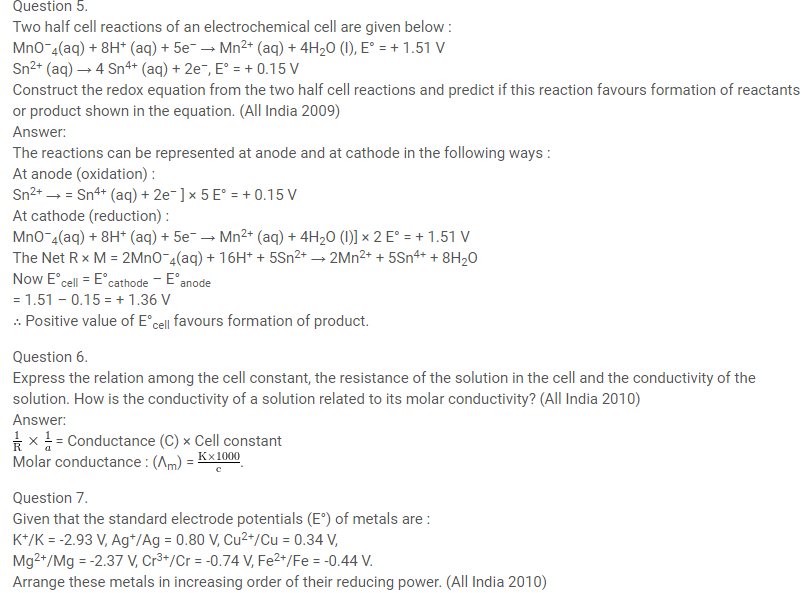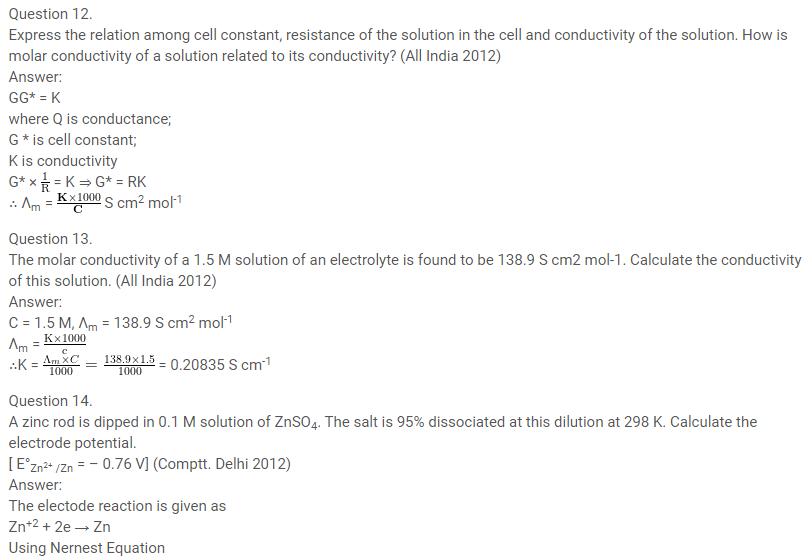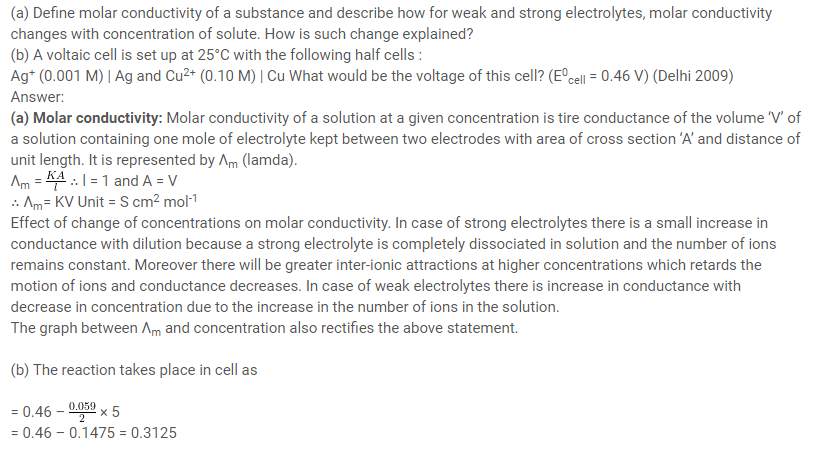Class 12 Electrochemistry Important Questions Very Short Answer Type
Question 1.
What is meant by ‘limiting molar conductivity’? (All India 2010)
Answer:
The molar conductivity of a solution at infinite dilution is called limiting molar conductivity and is represented by the symbol Λm.
Question 2.
Express the relation between conductivity and molar conductivity of a solution held in a cell. (Delhi 2011)
Answer:


Answer:
Ag+/Ag < Cu2+/Cu < Fe2+/Fe < Cr3+/Cr < Mg2+/ Mg < K+/K
More negative the value of standard electrode potentials of metals is, more will be the reducing power.
Question 8.
Two half-reactions of an electrochemical cell are given below :
MnO–4 (aq) + 8H+ (aq) + 5e– → Mn2+ (aq) + 4H2O (I), E° = 1.51 V
Sn2+ (aq) → Sn4+ (aq) + 2e–, E° = + 0.15 V.
Construct the redox reaction equation from the two half-reactions and calculate the cell potential from the standard potentials and predict if the reaction is reactant or product favoured. (All India 2010)
Answer:
The reactions can be represented at anode and at cathode in the following ways :
At anode (oxidation) :
Sn2+ → Sn4+ (aq) + 2e– ] × 5 E° = + 0.15 V
Af cathode (reduction) :
MnO–4(aq) + 8H+ (aq) + 5e– → Mn2+ (aq) + 4H2O (I)] × 2 E° = + 1.51 V
The Net R × M = 2MnO–4(aq) + 16H+ + 5Sn2+ → 2Mn2+ + 5Sn4+ + 8H2O
Now E°cell = E°cathode – E°anode
= 1.51 – 0.15 = + 1.36 V
∴ Positive value of E°cell favours formation of product.
Question 9.
The chemistry of corrosion of iron is essentially an electrochemical phenomenon. Explain the reactions occurring during the corrosion of iron in the atmosphere. (Delhi 2011)
Answer:
The mechanism of corrosion is explained on the basis of electrochemical theory. By taking example of rusting of iron, we Refer tothe formation of small electrochemical cells on the surface of iron.
The redox reaction involves
At anode : Fe(S) → Fe2+ (aq) + 2e–
At cathode : H2O + CO2 ⇌ H2CO3 (Carbonic acid)
H2CO3 ⇌2H+ + CO22-
H2O ⇌ H+ + OH–
H+ + e– → H
4H + O2 → 2H2O
Then net resultant Redox reaction is
2Fe(s) + O2 (g) + 4H+ → 2Fe2+ + 2H2O
Question 10.
Determine the values of equilibrium constant (Kc) and ΔG° for the following reaction :
Ni(s) + 2Ag+ (aq) → Ni2+ (aq) + 2Ag(s),
E° = 1.05 V
(1F = 96500 C mol-1) (Delhi 2011)
Answer:
According to the formula
ΔG° = -nFE° = – 2 × 96500 ×1.05
or ΔG° = -202650 J mol-1 = -202.65 KJ mol-1
Now ΔG° ⇒ -202650 J Mol-1
R = 8.314 J/Mol/K, T = 298 K
Question 11.
Two half-reactions of an electrochemical cell are given below :
MnO–4 (aq) + 8H+ (aq) + 5e– → Mn2+ (aq) + 4H2O (I), E° = 1.51 V
Sn2+ (aq) → Sn4+ (aq) + 2e–, E° = + 0.15 V.
Construct the redox equation from the standard potential of the cell and predict if the reaction is reactant favoured or product favoured. (Delhi 2011)
Answer:
The reactions can be represented at anode and at cathode in the following ways :
At anode (oxidation) :
Sn2+ → = Sn4+ (aq) + 2e– ] × 5 E° = + 0.15 V
At cathode (reduction) :
MnO–4(aq) + 8H+ (aq) + 5e– → Mn2+ (aq) + 4H2O (I)] × 2 E° = + 1.51 V
The Net R × M = 2MnO–4(aq) + 16H+ + 5Sn2+ → 2Mn2+ + 5Sn4+ + 8H2O
Now E°cell = E°cathode – E°anode
= 1.51 – 0.15 = + 1.36 V
∴ Positive value of E°cell favours formation of product.

Question 15.
Write the reactions taking place at cathode and anode in lead storage battery when the battery is in use. What happens on charging the battery ? (Comptt. All India 2012)
Answer:
At Anode: Pb + SO4-2 → PbSO4 + 2e
at Cathode : PbO2 + SO4-2 + 4H+ + 2e → PbSO4 + 2H2O
On charging the battery, the reaction is reversed and PbSO4 on anode and cathode is converted into Pb and PbO2 respectively.

Question 19.
The standard electrode potential for Daniell cell is 1.1 V. Calculate the standard Gibbs energy for the cell reaction. (F = 96,500 C mol-1) (Comptt. Delhi 2013)
Answer:
Given : E° = 1.1V, F = 96,500 C mol-5, n = 2
Zn + Cu2 ⇌ Cu + Zn2+
Using ΔG° = -nFE° = -2 × 96500 × 1.1
= 212,300 CV mol-1
Question 20.
State Kohlrausch law of independent migration of ions. Why does the conductivity of a solution decrease with dilution? (All India 2014)
Answer:
Kohlrausch law of independent migration of ions: The limiting molar conductivity of an electrolyte (i.e. molar conductivity at infinite dilution) is the sum of the limiting ionic conductivities of the cation and the anion each multiplied with the number of ions present in one formula unit of the electrolyte
Λ°m for AxBy = xλ°+ + yλ°–
For acetic acid Λ° (CH3COOH) = λ°CH3COO– + λ°H+
Λ°(CH3COOH) = Λ° (CH3COOK) + Λ° (HCl) – Λ° (KCl)
Question 21.
Define the following terms :
(i) Fuel cell
(ii) Limiting molar conductivity (Λ°m) (All India 2014)
Answer:
(i) Fuel cells : These cells are the devices which convert the energy produced during combustion of fuels like H2, CH4, etc. directly into electrical energy.
(ii) The molar conductivity of a solution at infinite dilution is called limiting molar conductivity and is represented by the symbol Λ°m.
Question 22.
Define the following terms :
(i) Molar conductivity (Λm)
(ii) Secondary batteries (All India 2014)
Answer:

Question 25.
Define conductivity and molar conductivity for the solution of an electrolyte. Discuss their Variation with change in temperature. (Comptt. All India 2014)
Answer:
Conductivity: Conductivity of a solution is defined as the conductance of a solution of 1 cm length and having 1 sq. cm as the area of cross-section. It is represented by K.
Its unit is S cm-1
Molar conductivity : Molar conductivity of a solution at a dilution V is the conductance of all the ions produced from one mole of the electrolyte dissolved in V cm3 of the solution when the electrodes are 1 cm apart and the area of the electrodes is so large that the whole of the solution is contained between them. It is represented by Λm.
Its unit is S cm2 mol-1
Conductivity and molar conductivity of electrolytes increase with increasing temperature.
Question 26.
(a) Following reactions occur at cathode during the electrolysis of aqueous silver chloride solution :
Ag+(aq) + e– → Ag(s) E° = +0.80 V
H+(aq) + e– → H2(g) E° = 0.00 V
On the basis of their standard reduction electrode potential (E°) values, which reaction is feasible at the cathode and why?
(b) Define limiting molar conductivity. Why conductivity of an electrolyte solution decreases with the decrease in concentration? (Delhi 2015)
Answer:
(a) At the cathode Ag+ (aq) + e– → Ag(s)
reaction is feasible, because Ag+ ion has higher reduction potential i.e. higher E° value.
(b) Limiting molar conductivity or the molar conductivity of solution at infinite dilution is the sum of molar conductivity cations and anions.
Conductivity of an electrolyte solution decreases on dilution because number of ions per unit volume decreases.

Question 29.
Calculate the degree of dissociation (a) of acetic acid if its molar conductivity (Λm) is 39.05 S cm2 mol-1.
Given: λ°(H+) = 349.6 S cm2 mol-1 and λ°(CH3COO–) = 40.9 S cm2 mol-1 (Delhi 2017)
Answer:
Λ°m(HAC) = λ°H+ + λ°AC–
= λ°CH3COOH = λ°H+ + λ°CH3COO–
= 349.6 S cm2 mol-1 + 40.9 S cm2 mol-1
= 390.5 S cm2 mol-1
Question 30.
Write the name of the cell which is generally used in hearing aids. Write the reactions taking place at the anode and the cathode of this cell. (All India 2017)
Answer:
Mercury cells are used in hearing aids.
Reaction at anode:
Zn (Hg) + 2OH– → ZnO (s) + H2O + 2e–
Reaction at cathode:
HgO + H2O + 2e– → Hg (l) + 2OH–
Question 31.
Write the name of the cell which is generally used in transistors. Write the reactions taking place at the anode and the cathode of this cell. (All India 2017)
Answer:
Leclanche cells (Dry cell) is used in transistors.
Reaction at Anode:
Zn(s) → Zn2+ + 2e–
At Cathode:
MnO2 + + e– → MnO(OH) + NH3
Question 32.
Write the name of the cell which is generally used in inverters. Write the reactions taking place at the anode and the cathode of this cell. (Delhi 2017)
Answer:
Lead storage battery is used in inverters.
At Anode:
Pb(s) + → PbSO4 (s) + 2e–
At Cathode:
PbO2(s) + + 4H+ (aq) + 2e–
PbSO4 (s) + 2H2O
Question 33.
Following reactions can occur at cathode during the electrolysis of aqueous silver nitrate solution using Pt electrodes :
On the basis of their standard electrode potential values, which reaction is feasible at cathode and why? (Comptt. All India 2017)
Answer:
As the standard electrode potential of silver is greater than that of the other hydrogen electrode, so reduction of silver takes place and reaction (i) will be feasible
i.e., + e– → Ag(s)
Question 34.
Following reactions may occur at cathode during the electrolysis of aqueous silver nitrate solution using silver electrodes :
On the basis of their standard electrode potential values, which reaction is feasible at cathode and why? (Comptt. All India 2017)
Answer:
The value of is positive due to higher standard electrode potential (E° = +0.80 V) of Ag+ than that of H+ so reaction (i) will be feasible at cathode
i.e. + e– → Ag(s). Silver has higher reduction potential.

Electrochemistry Class 12 Important Questions Short Answer Type -II [SA – II]
Question 36.
What is corrosion? Explain the electrochemical theory of rusting of iron and write the reactions involved in the rusting of iron. (Comptt. Delhi 2012)
Answer:
Corrosion: Corrosion is defined as the deterioration of a substance because of its reaction with its environment. Corrosion is an electrochemical phenomenon. At a particular spot of an object made of iron, oxidation takes place and that spot behaves as anode and the reaction is
At Anode : 2Fe → 2Fe+2 + 4e–
Electrons released at anodic spot move through the metal and go to another spot on the metal and reduce oxygen in presence of H+. This spot behaves as cathode
At Cathode : O2 + 4H+ + 4e-
Overall reaction : 2Fe + O2 + 4H+ → 2Fe+2 + 2H2O
Question 37.
When a certain conductance cell was filled with 0.1 M KCl, it has a resistance of 85 ohms at 25°C. When the same cell was filled with an aqueous solution of 0.052 M unknown electrolyte, the resistance was 96 ohms. Calculate the molar conductance of the electrolyte at this concentration.
[Specific conductance of 0.1 M KCl = 1.29 × 10-2 ohm-1 cm-1] (Comptt. All India 2012)
Answer:
Cell contant = Conductivity × Resistance
G* = K × R
= 1.29 × 10-2Ω-1 × 85
= 109.65 × 10-2Ω-1
= 1.0965 cm-1
Question 38.
(a) How many coulombs are required to reduce 1 mole Cr2O72- to Cr3+?
(b) The conductivity of 0.001 M acetic acid is 4 × 10-5 S/m. Calculate the dissociation constant of acetic acid if ,for acetic acid is 390 S cm2 mol-1. (Comptt. All India 2012)
Answer:
(a) Cr2O7-2 + 14H+ + 6e → 2Cr-3 + 7H2O
∴ 6 Faraday of charge is required
(b) Conductivity (K) = 4 × 10-5 S cm-1
Concentration (C) = 0.001M
Question 39.

Question 40.
(a) State and explain Kohlrausch law.
(b) How much electricity in terms of Faradays is required to produce 20 g of calcium from molten CaCl2? (Comptt. Delhi 2013)
Answer:
(a) Corrosion is an electrochemical phenomenon. At a particular spot of iron j oxidation it takes place and the spot behaves j as anode and the reaction will be: i
At anode :
2Fe(s) → 2Fe2+ + 4e–
Electrons released above move through the metal to another spot and reduce oxygen in presence of H+ and the spot behaves as cathode with the reaction.
At cathode :
O2(g) + 4H+ (aq) + 4e– → 2H2O(I)
Overall reaction :
2Fe(s) + O2(g) + H+(aq) → 2Fe2+(aq) + 2H2O (l)
The ferrous ions are further oxidised by atmospheric oxygen to form hydrated ferric oxide (Fe2O3 xH2O) as rust.
(b) Ca22+ + 2e– → Ca
Thus, 1 mole of Ca i.e. 40 g of Ca requires electricity = 2F
∴ 20 g of Ca will require electricity = 1F
Question 41.
(a) Calculate ΔrG0 for the reaction
Mg (s) + Cu2+ (aq) → Mg2+ (aq) + Cu (s)
Given : E0cell = + 2.71 V, 1 F = 96500 C mol-1
(b) Name the type of cell which was used in Apollo space programme for providing electrical power. (All India 2014)
Answer:
(a) ΔrG0 = – nFE0
= -2 × 96500 × 2.71 (∵ n = 2)
= -523,030 J mol-1 = -523.03 KJ mol-1
(b) Fuel cell was used in Apollo space programme for providing electrical power.
Question 42.

Question 43.
Calculate emf of the following cell at 25°C :
Fe | Fe2+ (0.001 M) || H+ (0.01 M) | H2(g) (1 bar) | Pt(s)
E0(Fe2+ | Fe) = -0.44 V E0(H+ | H2) = 0.00V (Delhi 2015)
Answer:
Fe | Fe2+ (0.001 M) || H+ (0.01 M) | H2(g) (1 bar) | Pt(s)
= 0.4105 Volts
Question 44.

Question 45.
Calculate e.m.f. of the following cell at 298 K: 2Cr(s) + 3Fe2+ (0.1 M) → 2Cr3+ (0.01 M) + 3 Fe(s)
Given: E0(Cr3+| Cr) = -0.74 V E0(Fe2+ | Fe) = -0.44 V (Delhi 2016)
Answer:
Cell reaction: 2Cr(s) + 3Fe2+ (0.1 M) → 2Cr3+ (0.01 M) + 3Fe(s)
Given: E0(Cr3+/Cr) = -0.74
E0(Fe2+/Fe) = -0.44 V
Question 46.

Question 47.
(a) The cell in which the following reaction occurs:
2Fe3+ (aq) + 2I–(aq) → 2Fe2+ (aq) + I2(s)
has = 0.236 V at 298 K. Calculate the standard Gibbs energy of the cell reaction. (Given: 1F = 96,500 C mol-1)
(b) How many electrons flow through a metallic wire if a current of 0.5 A is passed for 2 hours? (Given: 1F = 96,500 C mol-1) (All India 2017)
Answer:
(a) 2Fe3+ (aq) + 2I– (aq) → 2Fe2+ (aq) + I2 (s)
For the given reaction, n = 2, E° = 0.236 V
Using formula
ΔG° = -nF E°cell
= -2 × 96,500 C mol-1 × 0.236 V
∴ ΔG° =-45.55 kj mol-1
(b) Given:
I = 0.5 A
t = 2 hrs. = 2 × 60 ×60 s = 7,200 s
Q = I × t = 0.5 × 7200 = 3,600 C
96,500 C electricity flows to produce
= 6.022 × 1023 electrons
∴ 1 C electricity flows to produce
Question 48.
Why an electrochemical cell stop working after some time? The reduction potential of an electrode depends upon the concentration of solution with which it is in contact. (All India 2017)
Answer:
As the cell works, the concentration of reactants decrease. Then according to Le chatelier’s pri¬nciple it will shift the equilibrium in backward direction. On the other hand if the concentration is more on the reactant side then it will shift the equilibrium in forward direction. When cell works concentration in anodic compartment in cathodic compartment decreases and hence E° cathode will decrease. Now EMF of cell is
E0cell = E0cathode – E0anode
A decrease in E°cathode and a corresponding increase in E°anode will mean that EMF of the cell will decrease and will ultimately become zero i.e., cell slops working after some time.
Electrochemistry Class 12 Important Questions long Answer Type (LA)(Class 12 Electrochemistry)
Question 49.
